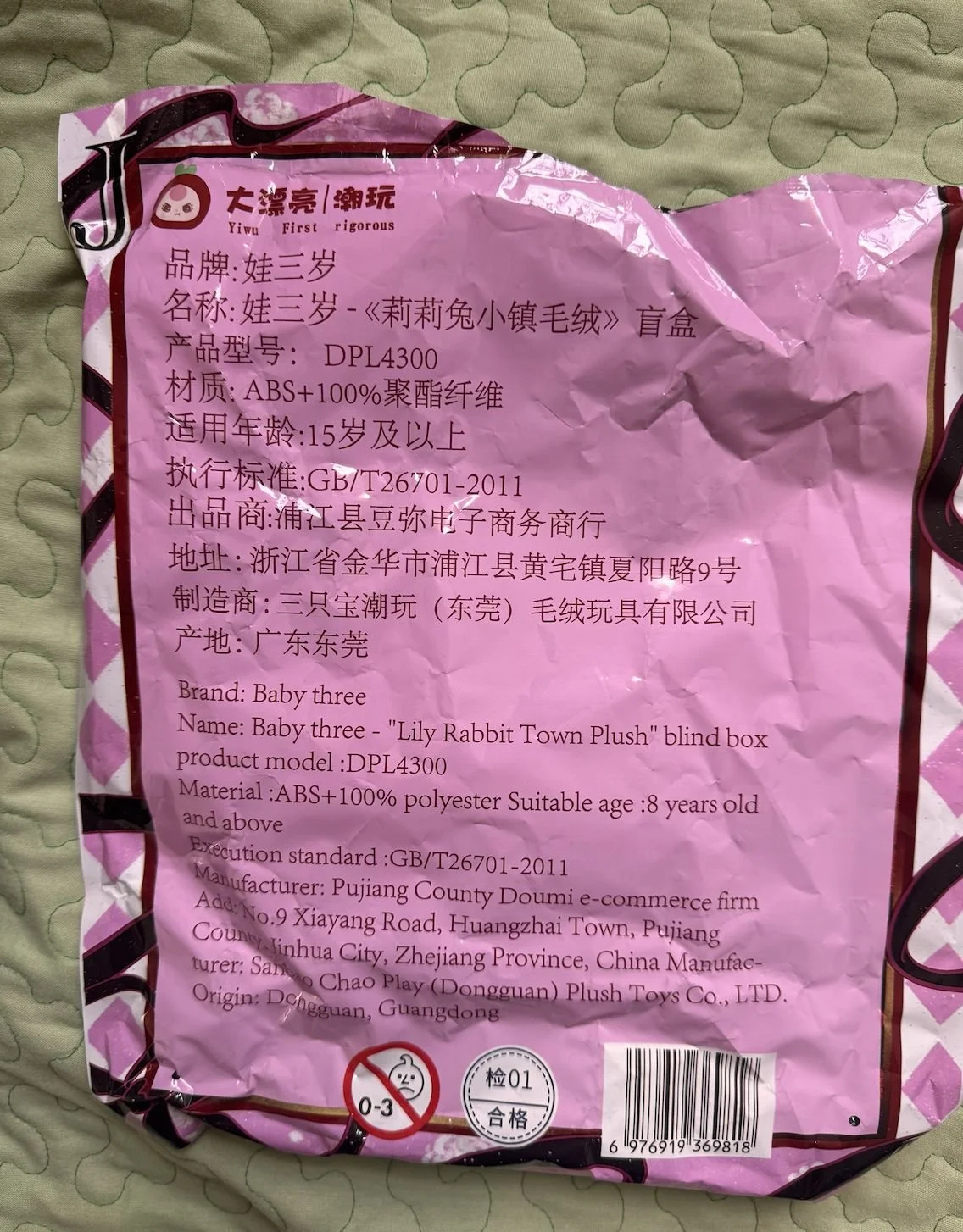Cute or Canceled? How This "Baby Three" Doll Became an International Controversy
Baby Three “Lily Rabbit Town” plush blind‑box figure, with an example of the face mark cited in the company’s “nine‑dash‑line” controversy. | Chase Burns Broderick
⏰ Tue, Jul 22, 2025 @ 2:00 PM PST | Updated on Thu, Jul 24 @ 3:30 PM
🐟 Published from Seattle, WA, USA
🔨 Built by Chase Burns Broderick
Last week, I opened up a box of unopened Baby Three dolls from a seller in Japan and loudly gasped when I saw what was inside—one of the alleged “nine-dash-line” Baby Threes.
Extreme close‑up of the Baby Three “Lily Rabbit Town” doll’s face. The mark in question is the blob between the white stars and heart. | Chase Burns Broderick
Baby Three’s Face-Tattoo Problem
What’s Baby Three?
Baby Three (Chinese: 娃三岁, Wá sān suì) is a Chinese blind‑box plush toy. Each box contains a mystery doll with a “baby” face, floppy animal ears, and often removable accessories. The toys appeal to Gen Z collectors. They first appeared in the Vietnamese market in 2024 and quickly went viral on TikTok.
Small Shape, Big Problem
In early March 2025, some fans online noticed that a version of a new variant (“Lily Rabbit Town V2”) had a strangely-shaped blob on its cheek shaped like China’s nine‑dash line, the disputed U‑shaped claim over most of the South China Sea. For Vietnam, that line is a red line: movies (Barbie) and even a bubble‑tea chain have experienced direct bans or widespread criticism for displaying it in Vietnam.
What’s the Nine‑Dash Line?
The nine‑dash line (also called the “cow’s‑tongue line”) is a U‑shaped maritime boundary printed on some Chinese maps to assert sovereignty over most of the South China Sea. A 2016 Hague tribunal ruled that China’s claims have no legal basis, but Beijing continues to use the line and it remains deeply contentious.
How a Boycott Unraveled
The controversy exploded in Vietnam when Anna Eyewear, a Vietnamese fashion‑accessories chain, announced it was terminating a collaboration with Baby Three. In a statement, the company explained it had planned to co‑produce 10,000 dolls for an upcoming collection but, after seeing the doll with the mark, it could not accept “any disrespect toward our national sovereignty.”
The statement:
"Our visit to the Baby Three headquarters in China opened up exciting new collaboration opportunities for 2025. However, today we have learned that the Baby Three ‘Town Bunny Ver. 2’ doll features inappropriate imagery. Whether intentional or accidental, we cannot accept any disrespect toward our national sovereignty. As a Vietnamese company and as Vietnamese citizens, we understand that protecting our country’s territorial integrity is our top priority. Therefore, we regret that we cannot proceed with this partnership between Anna and Baby Three."
Around the same time, in early March 2025, Đặng Tiến Hoàng, a prominent Vietnamese streamer and toy seller known as ViruSs, published a photo of him standing next to the CEO of Baby Three and said he was flying to China for a meeting with them. Very quickly after, as images of the marked doll went around Vietnamese social media, he announced he wouldn’t sell Baby Three any longer.
Seemingly overnight, Baby Three’s popularity in Vietnam seemed tanked. From France24:
Vendors in Hanoi told AFP that most of the offending dolls had been pulled from shelves, but their once-booming business has been shattered, with sales of all models vastly down.
Le, who declined to give her full name, said she used to regularly sell 100 Baby Three dolls a day for up to $20 each, but her sales had dwindled to almost nothing, with just a few now flogged at reduced rates.
"Almost all children started to boycott (the dolls) because they saw it as a nationalistic issue, thinking that buying Baby Three was unpatriotic," she said.
"I've invested so much money into this... it feels like such a waste," she added.
Packaging Timeline & International Stock Migration
The Baby Three (above) and its playing‑card-themed pouch in our photos (below) belongs to the original “Lily Rabbit Town V1” series wave that shipped in 2024, months before the uproar. Because V1 inventory had already been exported across Asia, Japanese marketplaces such as Mercari kept shipping sealed cartons worldwide through today—one of those Japanese lots is where our sample came from. Basically, this signals the face marking was in circulation in at least one earlier series.
Original Baby Three “Lily Rabbit Town” blind‑box pouch, the front artwork shows the doll in a black rabbit suit against a playing‑card‑style diamond motif. | Chase Burns Broderick
Reverse of the “Lily Rabbit Town” pouch, listing product specs, model DPL4300 and maker. | Chase Burns Broderick
Character card included in the blind‑box, depicting the grey‑green bunny‑suited Baby Three on a playing‑card backdrop. | Chase Burns Broderick
Chinese Sources SaID It’s Paranoia
Chinese sources insisted there was no political intent behind the doll’s design. When Vietnamese consumers and officials claimed that the Baby Three “Town Bunny Ver. 2” doll displayed China’s nine‑dash line, the toy’s manufacturer issued a statement saying the cheek pattern was simply Gothic‑style graffiti artwork with no geographical representation.
Still, in response, the company swiftly announced it had “decided to recall and destroy all products featuring this facial expression” and to “immediately cease production.”
It looks like one, however, made its way to me.






